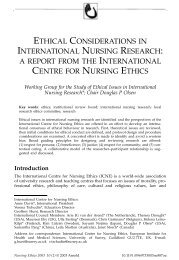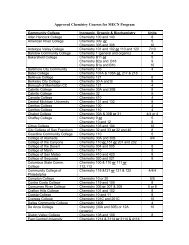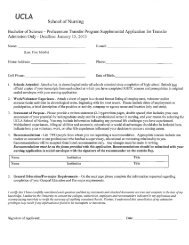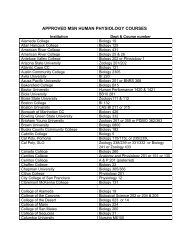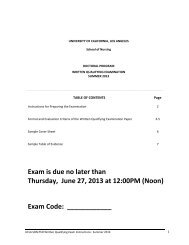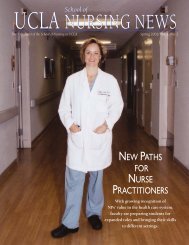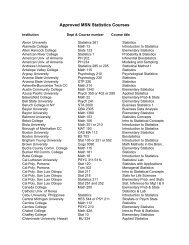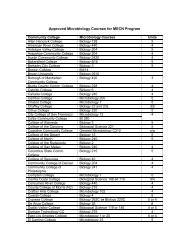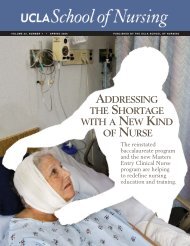Individual Fellowship Application Guide - UCLA School of Nursing
Individual Fellowship Application Guide - UCLA School of Nursing
Individual Fellowship Application Guide - UCLA School of Nursing
You also want an ePaper? Increase the reach of your titles
YUMPU automatically turns print PDFs into web optimized ePapers that Google loves.
PHS SF424 (R&R) <strong>Individual</strong> <strong>Fellowship</strong> <strong>Application</strong> <strong>Guide</strong>Regulations <strong>of</strong> the Food and Drug Administration (21 CFR 50, 21 CFR 56) generally apply to biomedicalresearch involving an unapproved drug, device or biologic and may apply to certain studies <strong>of</strong> approvedproducts. Additional information on FDA regulations is available athttp://www.accessdata.fda.gov/scripts/cdrh/cfdocs/cfcfr/cfrsearch.cfm. If work falls under FDA'sregulatory requirements, the grantee must follow both DHHS and FDA human subject protectionregulations.The National Institutes <strong>of</strong> Health <strong>Guide</strong>lines for Research Involving Recombinant DNA Molecules (NIH<strong>Guide</strong>lines) apply to all projects (NIH-funded and non NIH-funded) involving recombinant DNAmolecules that are conducted at or sponsored by an institution that receives NIH support for recombinantDNA research. See Part III, 2.9. Research Involving Recombinant DNA, including Human Gene TransferResearch.Federal requirements to protect human subjects apply to most research on human specimens (such ascells, blood, and urine), residual diagnostic specimens, and medical information. Research involvingexisting data, documents, records, pathological specimens, diagnostic specimens, or tissues that areindividually identifiable is considered “research involving human subjects.” The NIH Office <strong>of</strong>Extramural Research Human Subjects Web site contains additional information and Frequently AskedQuestions to help investigators understand how these federal requirements apply to their research. Seehttp://grants.nih.gov/grants/policy/hs/index.htm.The DHHS regulations require the NIH to evaluate all applications and proposals involving humansubjects (http://www.hhs.gov/ohrp/humansubjects/guidance/45cfr46.htm#46.120). This independentevaluation is conducted at the NIH through the peer review system and NIH staff review, and, as required,will take into consideration the risks to the subjects, the adequacy <strong>of</strong> protection against these risks, thepotential benefits <strong>of</strong> the research to the subjects and others, and the importance <strong>of</strong> the knowledge gainedor to be gained. On the basis <strong>of</strong> this evaluation, the NIH may approve or disapprove the application orproposal, or enter into negotiations to develop an approvable one.5.2 Vulnerable PopulationsInvestigators who conduct research involving pregnant women, human fetuses and neonates, prisoners (orsubjects who become prisoners after the research has started) or children, must follow the provisions <strong>of</strong>the regulations in Subparts B, C, and D <strong>of</strong> 45 CFR Part 46, respectively. The subparts describe theadditional protections required for conducting research involving these populations. Relevant informationmay be obtained at the OHRP Web site (http://www.hhs.gov/ohrp/policy/index.html).Exemptions 1-6 do not apply to research involving prisoners or subjects who become prisoners (seeSubpart C). Although Exemptions 1 and 3-6 apply to research involving children (see Subpart D),Exemption 2 can only be used for research involving educational testing or observations <strong>of</strong> publicbehavior when the investigator(s) do not participate in the activities being observed.5.3 Data and Safety Monitoring Plans for Clinical TrialsFor each proposed clinical trial, NIH requires a data and safety monitoring plan that describes oversightand monitoring to ensure the safety <strong>of</strong> participants and the validity and integrity <strong>of</strong> the data. The level <strong>of</strong>monitoring should be commensurate with the risks and the size and complexity <strong>of</strong> the clinical trial. Priorto the accrual <strong>of</strong> human subjects, a detailed data and safety monitoring plan must be submitted to theapplicant’s IRB and to the funding entity for approval. Adverse Events must be reported to the IRB, theNIH funding Institute or Center, and other appropriate <strong>of</strong>fices or agencies. This policy requirement is inaddition to any monitoring requirements imposed by 45 CFR Part 46. NIH policy specifically requires theestablishment <strong>of</strong> a Data and Safety Monitoring Board (DSMB) for multi-site clinical trials involvingPart II: Human SubjectsII-18



